Postcards From Armenia - #2 - May 3, 2004
Time to head to the “Marzs” or rural regions of Armenia. Last year I was able to visit schools and communities to the south and west of Yerevan. This year we headed to Tavush Marz, to the north. Tavush is known to be a green mountainous resort area. The two main towns are Dilijan and Ijevan. 18 of us set out in two mini vans or “Marshutkas” to do a little sightseeing on Sunday and run a training event at Ijevan school #5 on Monday.
Our route took us out past the outskirts of Yerevan and a slow climb up the plateau towards Lake Sevan, the largest lake and landmark in Armenia. Sevan sits at the base of a barren mountain range, running (how many miles? Gotta look it up) miles long. There are small resorts dotting the shore and many road side fishmongers, advertising their fish by holding out their hands indicating that they have “big fish.” Sevan also produces large crayfish. Last year I visited two monasteries on the shores of the lake. This time we waved as we headed towards the new tunnel to Tavush, reducing the number of sharp hairpin turns over the mountains from 14 to seven, all on the Tavush side.
Sevan had a few startling images, even as we flashed through. A woman standing by the side of the road holding a huge hawk by the wingtips, presumably dead and for sale. A house made out of a rusted old oil tank. Shepherds by the side of the road, watching over 6-12 muddy cows, occasionally right on the road. A fence around a cow pasture made of rusted out automobile hulks. An abandoned former soviet resort with a huge empty elevator tower. I suspect it was intended to descend from the hotel on the hill down to the lake, but it was unclear if it was ever finished. Like the huge half-finished “dachas” abandoned for lack of funds at the end of the Soviet era and the crash of the Armenian economy, there are echoes of decay everywhere. Yet there are strong signs of building in Yerevan. However, it is unclear if any of the growth benefits more than a few pockets, heavy with profit. They need places to spend/launder money and building seems to be the method of choice. Families also invest any savings in home building, even if it takes years and years to finish the house. You see people living in a lower story, still building above. Or many foundations indicating the beginning of a lifetime of savings for one’s own home.
Traveling through the new tunnel was pretty wild. First, the tunnel is fairly narrow and although new, does not feel quite so large or well lit as the tunnels I have been used to. Plus it was a gateway between two very different ecosystems. We entered the Sevan side of the 2 km tunnel with patches of snow on the treeless hills, grass still flattened by winter snow, and emerged in the green, birch covered slopes on the Tavush side. The new growth was brilliant and I felt like I had green lenses in my glasses. As we descended the remaining 7 hairpin turns (and yes, these were HAIRpin turns!) the trees had more leaves and spring flowers dotted the roadside, particularly the yellow primroses that grow on both sides of this mountain range.
Our first stop was Dilijan, a popular resort town that offers green, refreshing cool in the hot Armenian summers.
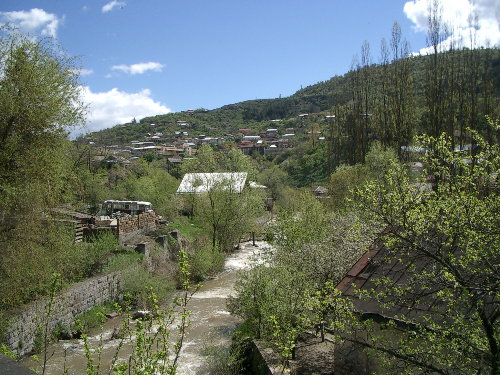 We walked up the hill to the original section of the town. There are plans to restore these wood and stone buildings along a green stone road as a tourist attraction. Now many of the ornately decorated wood porches are open, roofless to the sky.
We walked up the hill to the original section of the town. There are plans to restore these wood and stone buildings along a green stone road as a tourist attraction. Now many of the ornately decorated wood porches are open, roofless to the sky. 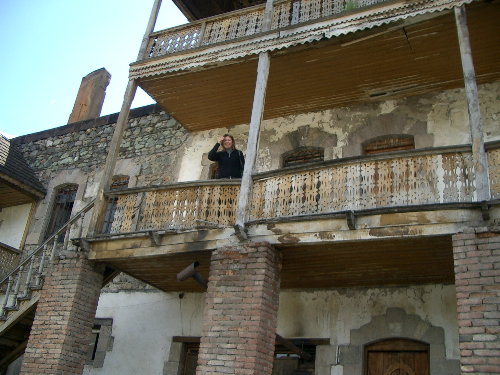 Curvaceous iron grill work guards rooms with trash and abandoned building materials. I hope they rescue the place in time, because it is beautiful, but in a fragile state of disrepair. The pattern of wood trim and wooden porches reminded me of old Tiblisi, not that much farther northwest.
Curvaceous iron grill work guards rooms with trash and abandoned building materials. I hope they rescue the place in time, because it is beautiful, but in a fragile state of disrepair. The pattern of wood trim and wooden porches reminded me of old Tiblisi, not that much farther northwest.  Unlike the drier parts of Armenia, there is plenty of wood so there is a break from the stone and metal style of building in most of the rest of the country. But the pyramidal basic structure of homes and buildings was consistent, each with porches for the summer sun. There was also this beautiful Armenian cross.
Unlike the drier parts of Armenia, there is plenty of wood so there is a break from the stone and metal style of building in most of the rest of the country. But the pyramidal basic structure of homes and buildings was consistent, each with porches for the summer sun. There was also this beautiful Armenian cross. 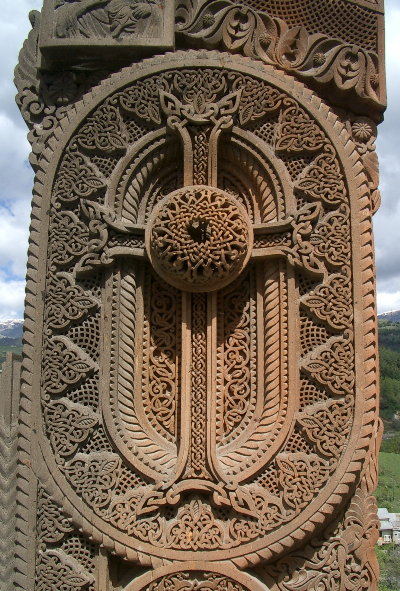
True to form with my Project Harmony colleagues there was much group picture taking, clowning around and strolling back down the hill arm in arm, snipping off bits of lilac and apple blossoms to put in our hair and in buttonholes. We know how to have fun.
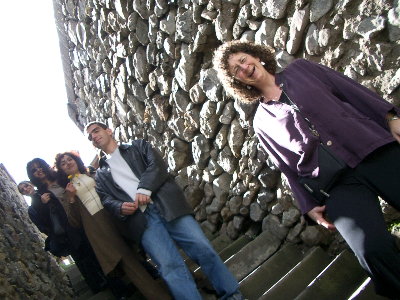 The lilacs, the famous in Dilijan, were just starting to open their buds, about 4 weeks behind my lilacs in Seattle. The apple blossoms interrupted the green swaths of birches, from white to a darker pink.
The lilacs, the famous in Dilijan, were just starting to open their buds, about 4 weeks behind my lilacs in Seattle. The apple blossoms interrupted the green swaths of birches, from white to a darker pink. One of the staff members from Dilijan had a special treat arranged for his coworker. Her brother was stationed in the army in Dilijan, serving his obligatory 2 year stint. Every able man serves two years after they conclude their education (high school or college). 6 months in basic then they are sent somewhere in the country. They are supposed to get one leave a year, but some never get theirs and others get more – bribes. Our team colleague had not seen her 20-year-old brother for 6 months, so there was a grateful 15-minute reunion while we loitered on the river’s edge.

Then we headed on to a side road where we climbed up a verdant valley along a stream to a monastery perched at the mountain ridge. Rusting picnic shelters dotted the riverside, popular in the warmer months, but some were filled this cool and sunny Sunday. The smoke from BBQ, an Armenian national tradition and passion, wafted in our windows.
We tumbled out of the marshutkas and walked around the monastery, lit candles in the church, and posed by a hollowed out old walnut tree.
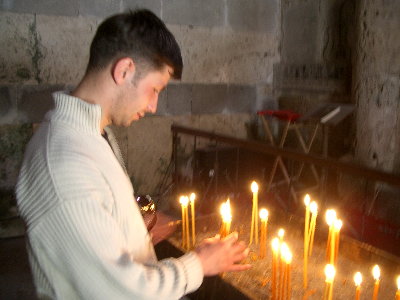 This set of buildings included the church, a library, a burial ground of a king and the larger monastery. It was built between the 11th and 13th century and like most sites in Armenia, has seen waves of attack, invasion and pillaging through the centuries, leaving only the massive hulk of the basic structures behind. There were a few columns that looked like pre-Christian Roman structures that might have formed some of the underlying structure of the buildings.
This set of buildings included the church, a library, a burial ground of a king and the larger monastery. It was built between the 11th and 13th century and like most sites in Armenia, has seen waves of attack, invasion and pillaging through the centuries, leaving only the massive hulk of the basic structures behind. There were a few columns that looked like pre-Christian Roman structures that might have formed some of the underlying structure of the buildings. 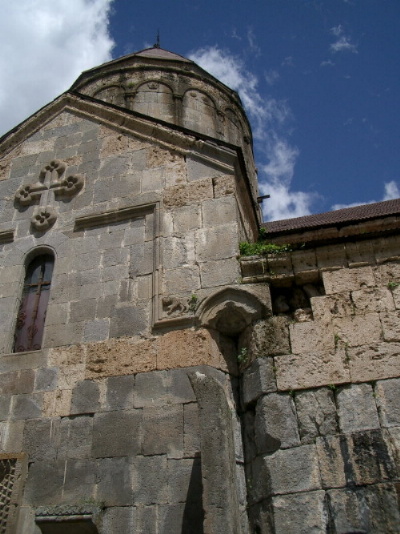
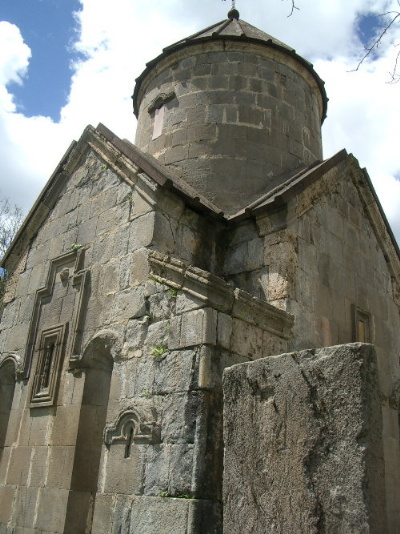

Beside the monastery was a small farmhouse painted green with bright blue beehives out front. I was ready to move in. Before we left, we all went into the old refectory where the gang sang a few Armenian folks songs, seeking an echo. The building was mute.
We walked down the hill a bit to an old gondola tower, now abandoned. More pictures, flower picking and clowning around till rumbling stomachs sent us on our way.
We headed back down the hill to one of the river side BBQ places, many with covered tables beside the VERY full and brown running river from winter snowmelt and last week’s strong rains. The river looked at the top of its bank, loud and insistent even on fairly flat stretches.
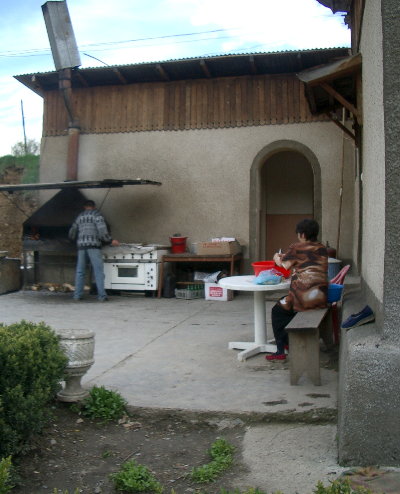
We had kebab, which is pork sausage cooled on a metal skewer and served with onions and flat Lavosh bread,
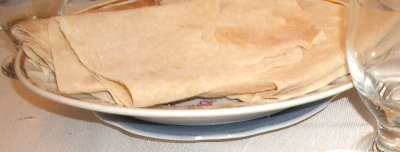 pickled spring shoots of two varieties ( I could not identify them), cheese, olives, tomatoes, cucumbers, more bread, then grilled pieces of pork and potatoes. We were full when we had dark small cups of Armenian coffee, which is addictive and sweet. I learned how to turn over my cup after I drained all the liquid with only the thick paste of fine grounds at the bottom. Depending on the pattern on both the plate and the cup, I could foretell my future.
pickled spring shoots of two varieties ( I could not identify them), cheese, olives, tomatoes, cucumbers, more bread, then grilled pieces of pork and potatoes. We were full when we had dark small cups of Armenian coffee, which is addictive and sweet. I learned how to turn over my cup after I drained all the liquid with only the thick paste of fine grounds at the bottom. Depending on the pattern on both the plate and the cup, I could foretell my future. 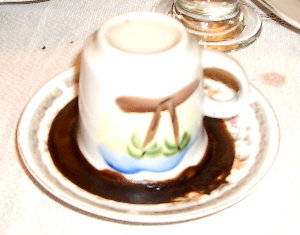

4 Comments:
What a wonderful article and great pictures. You are doing such a great job!!
Hi,
Thanks for the post, I am just did more or less the same places yesterday (12th Sept)and the weather was wet and cold, but the lake looked magnificent. I guess now that you have written, I dont have to write my OWN blog about these places.
Mathai, DO DO DO create your own blog. I'd love to read about your impressions of Sevan or anyplace. Somehow this ability to share the little moments in our life make the world a bit smaller for me. My dreamer's wish is that smaller might mean we can all live together a bit better.
I've now been to Sevan twice and both times it was COOOLLLDDD. A very chill air. The first time the monestary at the west end obscured in fog as we walked up the hill. I should find that picture. It was lovely!
Thanks Nancy for blogging your trip!! It was interesting to hear what you saw and love the pictures!! I came across your site by accident looking up info on the Tavush region. We are sponsoring a child there and wanted to know more about the area.
Post a Comment
<< Home